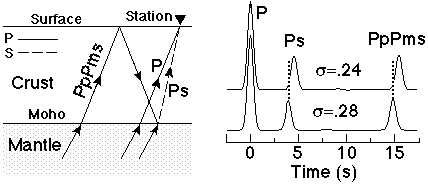
We measure the travel-times of converted waves in the P-waves of a teleseism recorded at a single seismic station to estimate the Vp/Vs of the crust beneath the site. A teleseismic P-wave incident on the base of the crust generates a converted S-wave (Ps) and a converted P-wave multiple (PpPms) within the crust (Fig. 1). The converted phases are isolated from source effects by deconvolving the vertical from the radial component of the P-waveform to produce a waveform called a receiver function. The ratio of the Ps-P time and the PpPms-Ps time is directly related to Vp/Vs independent of crustal thickness but with a slight dependence on Vp; for a range in Vp of 6.0 to 6.75 km/s, the change in Vp/Vs is at most 0.05 and the change in Poisson's ratio is no more than 0.02.

Figure 1. (Left) Geometry of raypaths for the P-wave, converted wave Ps, and multiple converted wave PpPms generated by a teleseismic plane wave interacting with the impedance contrast at the base of the crust. (Right) Synthetic receiver functions for a crust with Poisson's ratio of 0.24 (top) and 0.28 (bottom). We calculate Vp/Vs (then Poisson's ratio) from the ratio of differential timePoisson's ratio (Ps-P)/(PpPms-Ps) and estimate the crustal thickness using the Ps-P time and the estimated value of Vp/Vs for a range of average crustal P-velocities. The main assumption in this method is that the Ps and PpPms phases propagate in a laterally uniform crust over the distance sampled by the phases (20-50 km). A tangential receiver function is non-zero only in the presence of lateral heterogeneity and is used to assess the quality of measurements made using the radial receiver function. We minimize the impact of lateral heterogeneity on our results and enhance the multiples by using data with periods longer than 3 to 5 seconds.

Figure 2. Global variation of Poisson's ratio measured at digital broad-band seismograph stations accessible through international, national, and regional data centers. The crust is divided into five categories. Shields are areas of exposed Precambrian age crust, usually found in the interiors of the major continents. Platforms (Plat) are shield-like crust with 1- to 5-km thick sedimentary cover. Orogenic belts are curvilinear regions of crust that have experienced one or more Phanerozoic age tectonic events. Paleozoic (Pal) orogenic belts are relatively stable with eroded mountains lacking significant crustal roots. Mesozoic/Cenozoic (M/C) belts are often still tectonically active, with considerable surface relief and crustal thickness variations. Island arcs (IA) form at ocean-ocean convergence zones and are regions of oceanic crust thickened by magmatic additions. Continental volcanic arcs are included in the M/C orogenic belts.

Figure 3. Stacked histogram of all Poisson's ratio measurements sorted into 0.02 bins and stacked by crustal type (see Fig. 2 for definitions of crustal types).